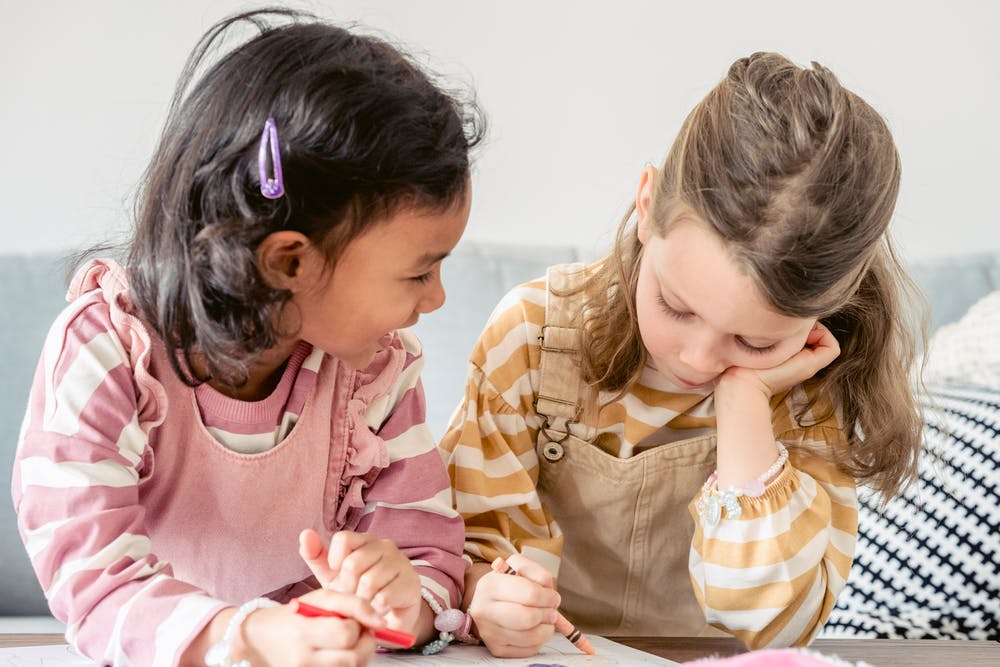How Does Child-led Learning Elevate Winter Play?
 This season, often associated with cozy indoor activities, can also serve as a vibrant backdrop for childcare learning, particularly through the lens of the Montessori philosophy. By embracing childcare training and the unique opportunities that winter presents, #parents and #educators can inspire children to engage in hands-on exploration, fostering independence, creativity, and a deeper connection to nature.
This season, often associated with cozy indoor activities, can also serve as a vibrant backdrop for childcare learning, particularly through the lens of the Montessori philosophy. By embracing childcare training and the unique opportunities that winter presents, #parents and #educators can inspire children to engage in hands-on exploration, fostering independence, creativity, and a deeper connection to nature.
Child-Led Learning
Child-led learning is a fundamental aspect of the Montessori philosophy, and it is particularly effective during winter #play. Here are several key aspects to consider:
-
Autonomy and Choice: Children thrive when given the #freedom to choose their activities. In a winter setting, this could mean deciding whether to build a snowman, create snow angels, or engage in a snowball fight. Childcare training for the caregivers allows the children to make these choices, fostering a sense of ownership over their learning and encouraging them to pursue their interests.
-
Exploration and Discovery: Winter presents unique opportunities for exploration. Children can investigate the properties of snow and ice, observe animal tracks, or examine the different textures of winter materials. This hands-on exploration #nurtures curiosity and critical thinking, as children learn to ask questions and seek answers through their experiences.
-
Creativity and Imagination: Engaging in winter play allows children to #express their creativity. Whether they are designing a snow fort or crafting a snow sculpture, they can use their imagination to create something unique. This process not only enhances their creative skills but also boosts their confidence as they see their ideas come to life.
-
Physical Development: Winter activities often involve physical exertion, which is essential for #developing #gross-motor-skills. Activities like sledding, snowball throwing, and building snow structures help children develop strength, coordination, and balance. These physical experiences are crucial for their overall #health-and well-being.
-
Social Skills and Collaboration: Childcare training encourages winter play which involves group activities, providing opportunities for children to collaborate and communicate with their peers. Working together to build a snowman or engage in a snowball fight teaches teamwork, negotiation skills, and the importance of sharing ideas and responsibilities.
-
Connection to Nature: The Montessori method emphasizes the importance of connecting with nature. Winter play allows children to engage with their environment, observe seasonal changes, and develop a sense of responsibility for the natural world. This connection fosters an appreciation for nature and encourages environmentally responsible behaviors.
Montessori Winter Learning Activities
-
Exploring Snow and Ice: Montessori Activities for Winter Science
- Ice Sculptures: Ice serves as a fantastic medium for creativity and scientific inquiry as per childcare trainings. Gather small natural items such as leaves, twigs, and berries, and #freeze them in ice cubes or larger blocks. Children can observe the melting process, discussing the science behind ice formation, the behavior of water molecules, and the effects of temperature changes. This activity not only sparks curiosity but also enhances their understanding of physical changes in nature.
- Snow Tracking and Animal Observations: A winter walk provides an exciting opportunity to explore animal tracks in the snow. Encourage children to identify and discuss the tracks left behind by various animals, such as deer, rabbits, or squirrels. This activity fosters keen observation skills and invites curiosity about wildlife adaptations to cold weather, enhancing their connection to the natural world.
-
Indoor Nature-Inspired Activities for Cold Days
- Create a Winter Nature Collage: Collect natural materials from previous outdoor explorations, such as pinecones, dried leaves, and acorns. Children can use these items to create a winter-themed collage, promoting fine motor skills through cutting, gluing, and arranging. This activity encourages reflection on the beauty of winter and enhances vocabulary related to textures and colors, allowing children to express their creativity indoors.
- Winter Bird Watching: Set up a cozy indoor spot near a window for bird watching. Provide binoculars and a bird identification book, allowing children to observe local bird species and learn about their behaviors during winter. This engaging activity helps develop observation skills and fosters an appreciation for wildlife, even in the colder months.
-
Outdoor Winter Exploration for Montessori Children
- Nature Walks: Encourage children to take walks in the winter, practicing independence and responsibility while engaging with nature. Snow can serve as a canvas for creative play, and frozen ponds or rivers can introduce concepts of states of matter and environmental change. This hands-on exploration nurtures their understanding of the environment.
- Making Snow Sculptures: Allow children to express their creativity by building snow sculptures. This activity not only teaches about nature but also encourages mindfulness and appreciation for the slower pace of winter life. Children can experiment with different shapes and designs, fostering their artistic expression and reinforcing their connection to the season.
Outdoor Winter Activities
Here are some engaging outdoor winter activities that can enhance your child’s experience in the snow:
-
Snowflake Exploration: Encourage your child to catch snowflakes on dark paper and examine their unique structures using a magnifying glass. This activity can #lead to discussions about symmetry and the science of snow, sparking an interest in natural phenomena.
-
Nature Art: Use sticks, rocks, and other natural materials to create patterns or write names in the snow. This activity combines creativity with fine motor skills, allowing children to express themselves artistically while interacting with their environment.
-
Practical Life Skills: Involve your child in shoveling snow or clearing pathways. These tasks not only teach responsibility but also provide a sense of accomplishment and teamwork, reinforcing the value of contributing to family chores.
-
Snow Showers: Create a fun snow shower by shaking snow off tree branches. This #playful activity can lead to laughter and joy while exploring the properties of snow, enhancing sensory experiences.
-
Snow Volcano: Build a snow volcano using a plastic bottle filled with baking soda, then pour vinegar into it to create an exciting eruption. This activity introduces basic chemistry concepts in a fun and engaging way, making science accessible and enjoyable.
-
Animal Tracking: Go on a nature walk to identify animal tracks in the snow. Use a field guide or a mobile app to help your child learn about the animals that inhabit your area. This activity promotes observation skills and a deeper understanding of local wildlife.
-
Bird Watching: Set up a bird feeder and observe the different species that come to visit. This activity can spark discussions about wildlife and the importance of caring for our environment, fostering a sense of stewardship in children.
-
Winter Nature Walk: Organize a themed nature walk or a scavenger hunt to find winter-specific items like icicles, evergreen trees, or animal tracks. This encourages observation skills and a connection to nature, making the #outdoors a living #classroom.
-
Ice Sculptures: Collect natural materials and freeze them in water to create beautiful ice sculptures. This hands-on activity combines art with science, allowing children to explore the concept of freezing and melting in a creative context.
-
DIY Snow Paint: Mix food coloring with water in spray bottles and let your child paint on the snow. This colorful activity allows for artistic expression while enjoying the outdoors, turning the snowy landscape into a canvas.
-
Snow Cream: Teach your child how to make snow cream using fresh, clean snow, milk, and sugar. This delicious treat can be a fun way to enjoy the winter wonderland, combining culinary skills with #outdoor-play.
References
- https://montessorifromtheheart.com/2017/01/08/nature-walk-in-snow-winter-lake/
- https://themontessoriroom.com/blogs/montessori-tips/10-winter-montessori-activites?srsltid=AfmBOoqfRpdfoDElIZGUUnBcsL0vg5y9sbMWM2zcoW3iO7yZ24MnV0Pe
- https://www.namontessori.com/the-importance-of- #outdoor-play-in-the-winter/
- https://calgary #preschools.ca/blog/Montessori-Inspired+Winter+Play+Activities/96
- https://www.childcareed.com/a/the-great-snowman-debate-montessori-vs-traditional-methods-for-building-frosty-friends.html
- https://academyofthewinds.org/blog/14-tips-for-a-successful-winter-montessori-style
- https://applemontessorischools.com/blog/3-ways-to-bring-montessori- #home-this-winter-break
- https://www.montessoriinreallife.com/home/2021/2/14/gearing-up- #toddlers-for-all- #weather-play
- https://montessorifromtheheart.com/2020/01/09/taste- #safe-winter- #sensory-play/
- https://printables.montessorinature.com/outdoor-winter-activities/?srsltid=AfmBOorhOovGlOPPKF4a2JC75_uusErMaWRfs-SNRftlGURWBu2ycew7
- https://www.themomeducator.com/preschool-arctic-sensory-play-and-fake-snow/
- https://montessoriacademy.com.au/outdoor-play-in-winter/
- https://printables.montessorinature.com/child-led-play/?srsltid=AfmBOopR74oe9DxSwMEjDXIc303dubRL0v2EA-bHdxrPsN3SO7Dw8Iym
- https://www.yourstodefine.com/single-post/2019/11/28/montessori-winter-activities-for-toddlers
- https://therapyworks.com/blog/ #language- #development/games/winter-activities-that-boost-development/
- https://montessorifromtheheart.com/2017/01/08/nature-walk-in-snow-winter-lake/
- https://printables.montessorinature.com/outdoor-winter-activities/?srsltid=AfmBOorhOovGlOPPKF4a2JC75_uusErMaWRfs-SNRftlGURWBu2ycew7
- Health, safety and nutrition
- Professionalism
- Child development
- Community
- Infant/ Toddler
- Preschool
- School age
- Family Child Care
- Health and Safety
- Content Areas
- Social/Emotional
- Families
- Child Development
- Diversity, Equity, Inclusion
- Website Articles
- Health, safety and nutrition
- Curriculum and Environment
- Professionalism
- Child development
- Montessori
- CDA
- Child Guidance
- Balancing Active Play in Child Care
- Montessori Cultural Activities: Exploring the World Through Play and Learning
- Baby Play: Planning Infant and Toddler Activities
- Engaging Indoor Activities for Inclement Weather
- Play, Learn, Grow Online Version
- Play Safe, Think Big: Literacy Through Play
- Role of Play in Learning
- 18-Hour Family Child Care Renewal Training
- 24 Hour Family Child Care Pre-Service Training ONLINE
- ACEs and Resilience in Child Care
- How Does Child-led Learning Elevate Winter Play?
- 🧠Play with a Purpose: How Play-Based Learning Boosts Brainpower
- The Power of Play: How Play-Based Learning Shapes Development
- Hungry for Play: The Power of Play-Based Learning in Early Education
- Family Child Care/ Home Daycares Eligible for MD Child Scholarship Funding
- Let's Play! Supporting Child Development
- 🌟How Can Playtime Build Bright Minds? The Power of Learning Through Play in Early Childhood
- Why Every Parent and Educator Should Learn Adult, Child, and Infant CPR
- 🌴 Play, Learn, Teach: How to Become a Preschool Teacher in California
- 🌟Little Hands, Big Learning: Why Play is the Secret Ingredient to Early Childhood Growth
- Imaginative Play: How Your Child’s ‘Pirate Ship’ Might Just Be the Next Big Thing in Home Renovation
- Supporting child development through individualized learning.
- Elevate Your Career: From CDA Credential to Child Care Center Director in North Dakota with ChildCareEd
- Beyond the Basics: Specialized Child Care Training Courses That Elevate Your Expertise
- Snow Much Fun: Winter Sensory Activities to Enhance Child Development
- DAP Delight: Making Learning Joyful & Just Right for Every Child
- A Path to Engaged Learning: Play!
- How to Design Centers That Promote Both Play and Learning
- Playful Learning: How Games Help Preschoolers Grow
- What’s Going On in a Child’s Brain When They Play?


